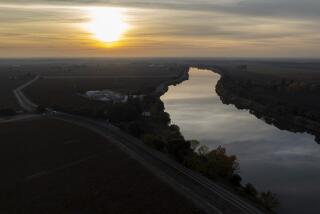Historic Wind Tunnel Blows Its Last Gale
- Share via
The paint is chipped with age and the big switches that run this great old beast of engineering look like something from a Frankenstein movie.
This Caltech wind tunnel is antiquated now but it has often been a crucial, if little-known, player on the world’s transportation stage.
There were times of war, when military leaders anxiously awaited the results of top-secret testing on desperately needed aircraft. In times of peace, the aerodynamic testing was more often aimed at prototype cars and motorcycles that would eventually take their places on American roads and in the nation’s culture.
The facility, part of Caltech’s Guggenheim Aeronautical Laboratory but known simply on campus as the “10-foot wind tunnel,” will be officially unplugged Monday, when it joins the ranks of history. The wind tunnel--cavernous enough to accommodate a big rig truck--is a giant rectangular doughnut, with a huge fan on the lower level pushing air through baffles and into the testing chamber above. Such contraptions to this day are key to testing how well airplanes and other vehicle move through air.
Caltech officials are shutting down the 68-year-old wind tunnel to make room for a smaller, high-tech model and more laboratories. Removal of the four-story facility begins when workers tear out wiring that dates to the age of the Victrola but has sustained the machine through the age of the jet fighter. The school plans a ceremony later in April to honor the technicians and others who did research at the wind tunnel--much of it cloaked in secrecy.
“The facility and the people who worked here deserve recognition,” said facility manager Gerald Landry, who has worked at the wind tunnel since 1973. “During its life, it was not allowed to have recognition.”
In an era before most aircraft manufacturers owned their own wind tunnels, the facility was especially important just before and during World War II as the site of round-the-clock testing on small-scale models of bomber planes such as the B-24 Liberator and B-17 Flying Fortress as well as the P-51 Mustang fighter.
Wind-tunnel testing of the B-29 Superfortress, the aircraft later used in the atomic bombing of Japan, turned up repeated glitches before that airplane ever took wing.
It was where engineers worked the design flaws out of Howard Hughes’ quirky Spruce Goose aircraft and, in later years, solved problems on a number of commercial passenger planes and even jet fighters.
“It was the granddaddy of them all,” said Wilfred McNay, who ran the facility for more than 20 years starting in the 1950s. “They tested so many airplanes I can’t even tell you.”
During World War II, armed guards kept vigil while teams of technicians scrambled to complete aerodynamics tests for aircraft firms hurrying to supply the military. The pace was frantic--they worked long hours making use of every sliver of daylight. Male employees rigged up the models and took the readings; female workers crunched the numbers on primitive calculators.
“I’ll tell you, they were in a hurry,’ said Lewis Balthasar, a senior technician who began work only days before the surprise attack on Pearl Harbor. “We had a tighter schedule than the tightest schedule anyone ever had.”
In the postwar years, the focus shifted increasingly to automobiles as car makers bought up blocks of time at the tunnel to make their new models as sleek as possible.
The massive apparatus has been used to examine the effect of wind on bridges, buildings and stadiums--even to help an Olympic sledder figure out how to cut air resistance as she screamed down the course.
Few Americans might know about that varied past, but the wind tunnel is famous among the cognoscenti of the aeronautics world. Landry said it was third on the list of must-see destinations for a group of Russian scientists who visited in 1991--right behind New York City and Disney World.
Visitors will have to go to aviation museums to view the parts that will be saved, Landry said. Some of the sensitive measuring equipment is being sent to the Smithsonian Institution’s National Air and Space Museum in Washington, D.C. A Florida museum operator has expressed interest in salvaging a large section of the apparatus, Landry said.
Except for the 10-by-10-foot test chamber, where the effects of air reaching up to 160 mph can be viewed through windows, the facility is much the same as when built in 1929, the brainchild of aeronautics pioneer Theodore von Karman and then the largest such facility on the West Coast. Even the motor is original, taken from a World War I submarine prototype.
The blades for the 15-foot fan once came unhinged at full speed, creating such an unholy crash that workers in a neighboring building thought there had been an earthquake. “This is basically very large Cuisinart,” Landry said. “Things can get ugly quick.”
A 1987 earthquake severely damaged the hypersensitive measuring equipment needed for studying aircraft, and the wind tunnel was effectively sidelined from the airplane business. Landry said it would cost $1 million to make complete improvements.
“It’s sad to see it go, but . . . things have to happen. The only constant being change holds true here too,” Landry said.
More to Read
Inside the business of entertainment
The Wide Shot brings you news, analysis and insights on everything from streaming wars to production — and what it all means for the future.
You may occasionally receive promotional content from the Los Angeles Times.










